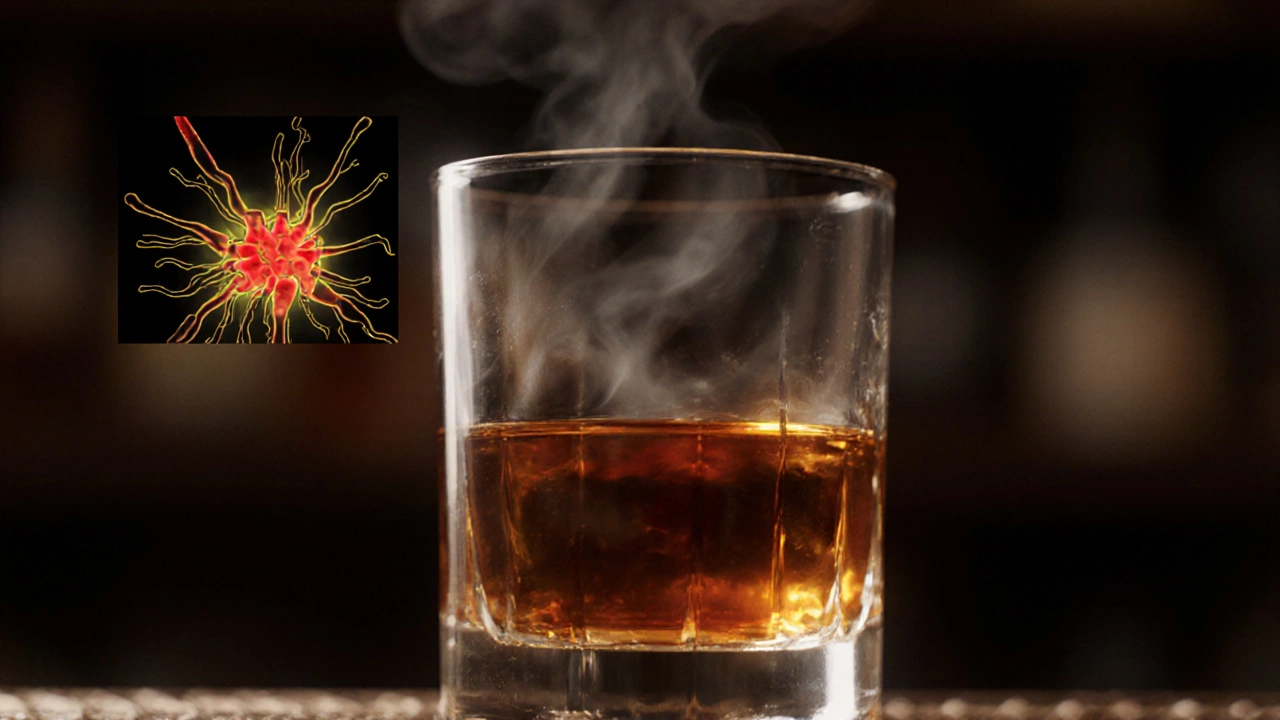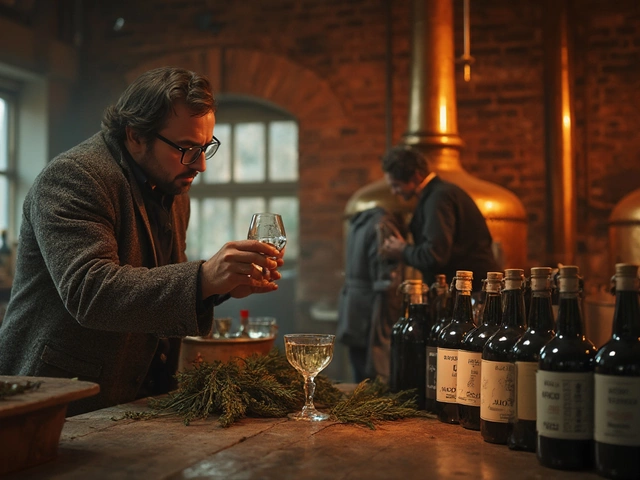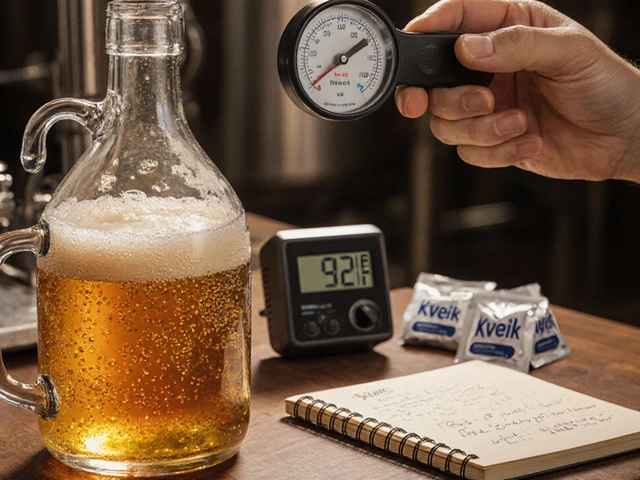Non-Alcoholic Burn Simulator
Explore how different ingredients can replicate the burning sensation of alcohol. Select one or more ingredients below to see how they work together.
Bitters
Alkaloids & aromatic resins
Bitter, herbal, aromaticGinger
Gingerol
Spicy-sweet, warmSzechuan Peppercorn
Sanshool
Numbing, citrusyBlack Pepper
Piperine
Sharp, earthyChili Peppers
Capsaicin
Hot, fruityVinegar
Acetic acid
Tart, tangyBurn Simulation Result
Ever wondered why a sip of whisky makes your throat tingle and then leaves a warm glow? That sharp, tingling sensation is called the alcohol burn - a quick, heating feeling caused by ethanol stimulating sensory nerves in the mouth and throat. If you’re cutting back, driving, or just prefer a sober night, you might miss that little sting. The good news? A handful of ingredients can recreate that bite without any booze.
Key Takeaways
- The burn comes from ethanol’s effect on nerve receptors and can be replicated with high‑acid, spicy, or bitter compounds.
- Bitters, ginger, Szechuan peppercorn, black pepper, chili, vinegar, and carbonated water are the top non‑alcoholic substitutes.
- Each alternative brings its own flavor profile, so you can tailor mocktails to your taste or the drink you’re mimicking.
- Health‑wise, most of these options are safe in moderation, but watch sodium in bitters and capsaicin if you’re sensitive.
- Use the quick‑cheat table below to pick the right “burn” for any occasion.
Why does alcohol create a burn?
Ethanol is a small, volatile molecule. When it contacts the mucous membranes of your mouth, it activates the TRPV1 receptors - the same ones that react to heat and capsaicin. The brain interprets that signal as a warm, sometimes burning sensation. The intensity depends on proof, temperature, and how long the liquid stays on your tongue.
Understanding that chemistry helps you match the sensation with other compounds that trigger the same receptors.
Non‑alcoholic ingredients that hit the same nerve
Below are the most common kitchen and bar staples that can fake the alcohol burn. Each entry contains a brief definition, the compound that creates the sting, and a quick tip for mocktail use.
1. Bitters
Bitters are concentrated herbal extracts flavored with bittering agents like gentian, quinine, and aromatic spices. The main burn comes from alkaloids and aromatic resins that activate TRPV1 receptors. A dash adds depth to a non‑alcoholic Old Fashioned or a spritz without turning the drink sweet.
2. Ginger
Gingercontains gingerol, a compound chemically similar to capsaicin, which produces a warming, mildly spicy bite. Fresh grated ginger or ginger syrup can give a Moscow Mule mocktail that feels “hot” even though it’s alcohol‑free.
3. Szechuan Peppercorn
Szechuan peppercorndelivers a unique “numbing‑tingle” caused by hydroxy‑α‑sanshool, which stimulates the same sensory pathways as alcohol. A few cracked pods in a citrus mocktail create a buzz that’s almost electric.
4. Black Pepper
Black peppercontains piperine, a spicy alkaloid that can mimic a mild burn when freshly ground into a drink. Sprinkle a pinch into a tomato‑based virgin Bloody Mary for that extra kick.
5. Chili Peppers
Chili peppersprovide capsaicin, the classic heat molecule that lights up TRPV1 receptors. A few drops of chili‑infused simple syrup turn a fruity mocktail into a fiery treat.
6. Vinegar
Vinegaroffers sharp acidity (acetic acid) that creates a quick, puckering sensation similar to a high‑proof spirit’s bite. A splash of apple cider vinegar brightens a low‑sugar spritzer.
7. Carbonated Water
Carbonated waterdelivers a fizzy “sting” as CO₂ bubbles burst on the tongue, mimicking the lively mouthfeel of sparkling spirits. Use it as a base for any mocktail that needs lift.
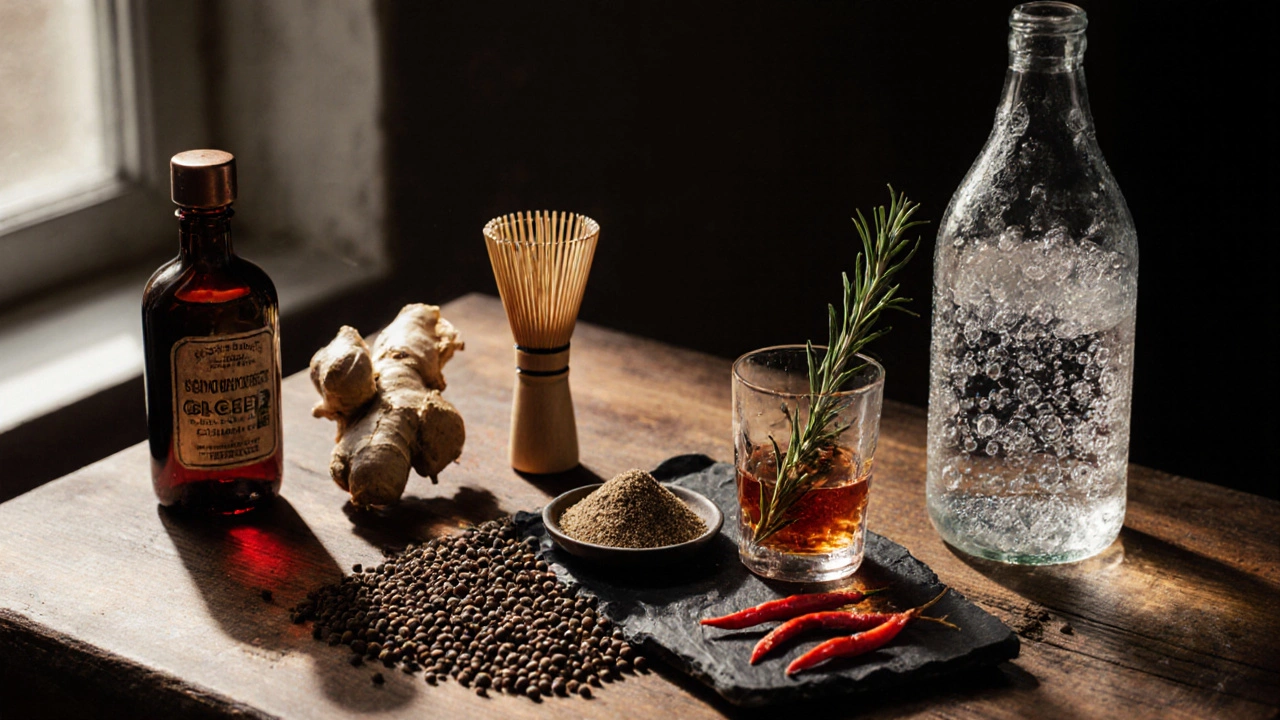
Quick‑Cheat Comparison Table
| Ingredient | Key Burn Compound | Flavor Profile | Typical Use | Intensity (1‑5) |
|---|---|---|---|---|
| Bitters | Alkaloids & aromatic resins | Bitter, herbal, aromatic | Dash in mocktails, bitters‑wide | 3 |
| Ginger | Gingerol | Spicy‑sweet, warm | Fresh juice, syrup | 3 |
| Szechuan Peppercorn | Sanshool | Numbing, citrusy | Cracked, infused water | 4 |
| Black Pepper | Piperine | Sharp, earthy | Fresh grind, garnish | 2 |
| Chili Peppers | Capsaicin | Hot, fruity (varies) | Infused syrup, garnish | 5 |
| Vinegar | Acetic acid | Tart, tangy | Splash in spritzers | 2 |
| Carbonated Water | CO₂ bubbles | Bright, effervescent | Base for any mocktail | 1‑2 |
Building a mocktail that feels like the real thing
Now that you know the ingredients, here’s a step‑by‑step method to craft a balanced, burn‑filled mocktail.
- Pick a base liquid: sparkling water, tea, or a light juice.
- Choose a primary burn agent: bitters for subtle bitterness, ginger for warm spice, or chili for bold heat.
- Add a secondary accent: a splash of vinegar for acidity or a pinch of cracked black pepper for depth.
- Balance with sweetness: agave, honey, or a fruit puree.
- Finish with garnish that echoes the burn (e.g., a thin slice of fresh ginger or a few Szechuan peppercorns).
Example: Spicy Ginger Spritz
- 2oz ginger syrup
- ¼oz apple cider vinegar
- 3 dashes aromatic bitters
- Top with sparkling water
- Garnish with a thin ginger slice and a crack of Szechuan peppercorn
Health considerations
All the ingredients above are generally safe, but keep a few points in mind:
- Bitters can be high in sodium; check the label if you watch blood pressure.
- Capsaicin (chili) may irritate the digestive tract in large amounts; start with a few drops.
- Ginger can thin blood; people on anticoagulants should moderate intake.
- Vinegar is acidic; overuse can erode enamel-always dilute.
- Carbonated water is fine for most, but excess can cause bloating.
Use the burn elements sparingly and taste as you go; you’ll get the desired sensation without overloading your palate.
Quick cheat sheet for the busy host
- Want mild warmth? Use a dash of bitters or a splash of vinegar.
- Craving a spicy kick? Add ginger juice or a few drops of chili‑infused syrup.
- Looking for that electric tingling? Sprinkle cracked Szechuan peppercorns on top.
- Need effervescence? Top with carbonated water and a pinch of black pepper.
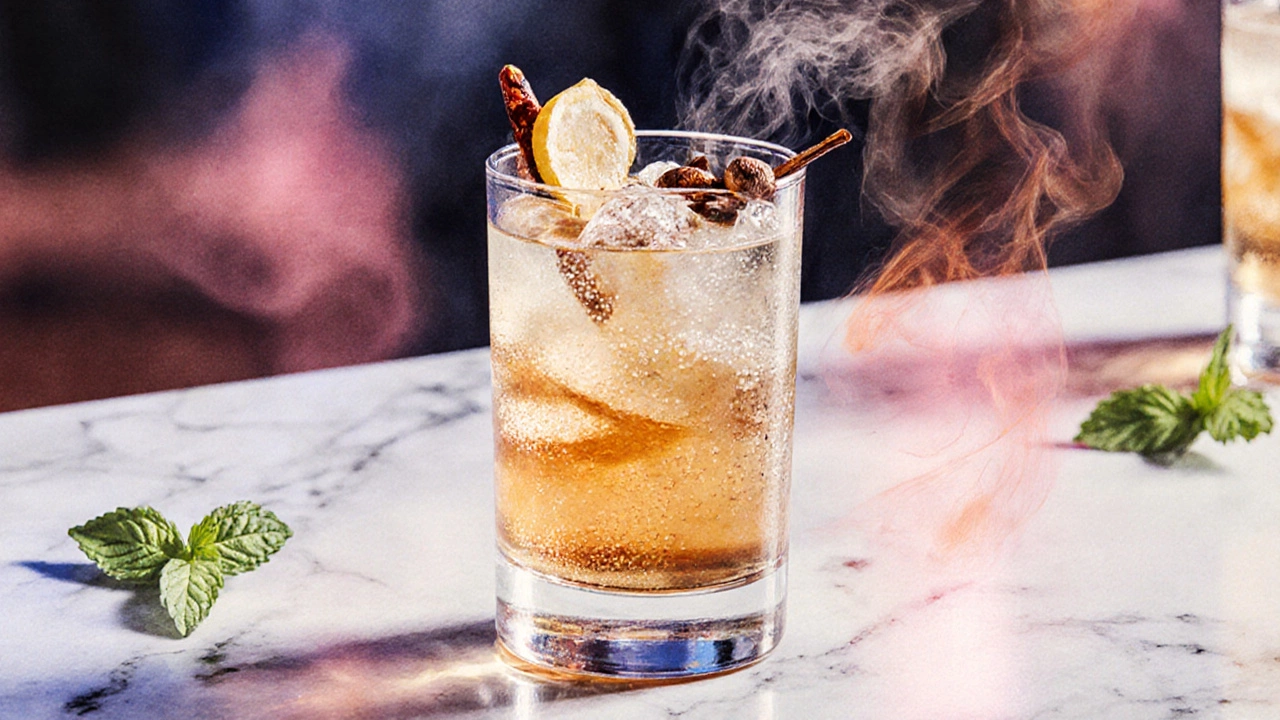
Frequently Asked Questions
Can I use regular table salt instead of bitters for a burn?
Salt won’t trigger the TRPV1 receptors the way bitters do, so it won’t give you that authentic burn. It can add a sharp edge, but the sensation is completely different.
Is there a vegan-friendly bitter?
Most commercial bitters are vegan, but always check the label for animal‑derived colorings or honey. Brands like Angostura and Fee Brothers list their ingredients clearly.
How much ginger is too much in a mocktail?
A typical serving is ½oz to 1oz of ginger juice or syrup per 8oz drink. Going beyond 2oz can dominate the flavor and become harsh.
Can I combine several burn agents?
Absolutely! Layering ginger with a dash of bitters and a pinch of Szechuan peppercorn creates a complex, multi‑dimensional bite that mimics the depth of a fine spirit.
Do carbonated drinks cause a burning sensation?
The fizz creates a slight “sting” as CO₂ bubbles burst, but it’s milder than alcohol. Pair it with a bitter or spicy element for a fuller effect.
What’s the best way to store infused bitters at home?
Keep them in a cool, dark cabinet away from direct sunlight. A sealed glass bottle will preserve the flavor for up to two years.
Are there any non‑alcoholic drinks that naturally have a burn?
Yes-kombucha can have a slight acidic “bite,” and traditional ginger kombucha often feels warm on the palate.
Whether you’re hosting a sober soirée or just want to experiment, these alternatives let you enjoy the same thrilling burn that makes a spirit feel alive-without the alcohol. Pick the ingredient that fits your taste, adjust the intensity, and you’ll have a mocktail that feels just as exciting as its boozy counterpart.
